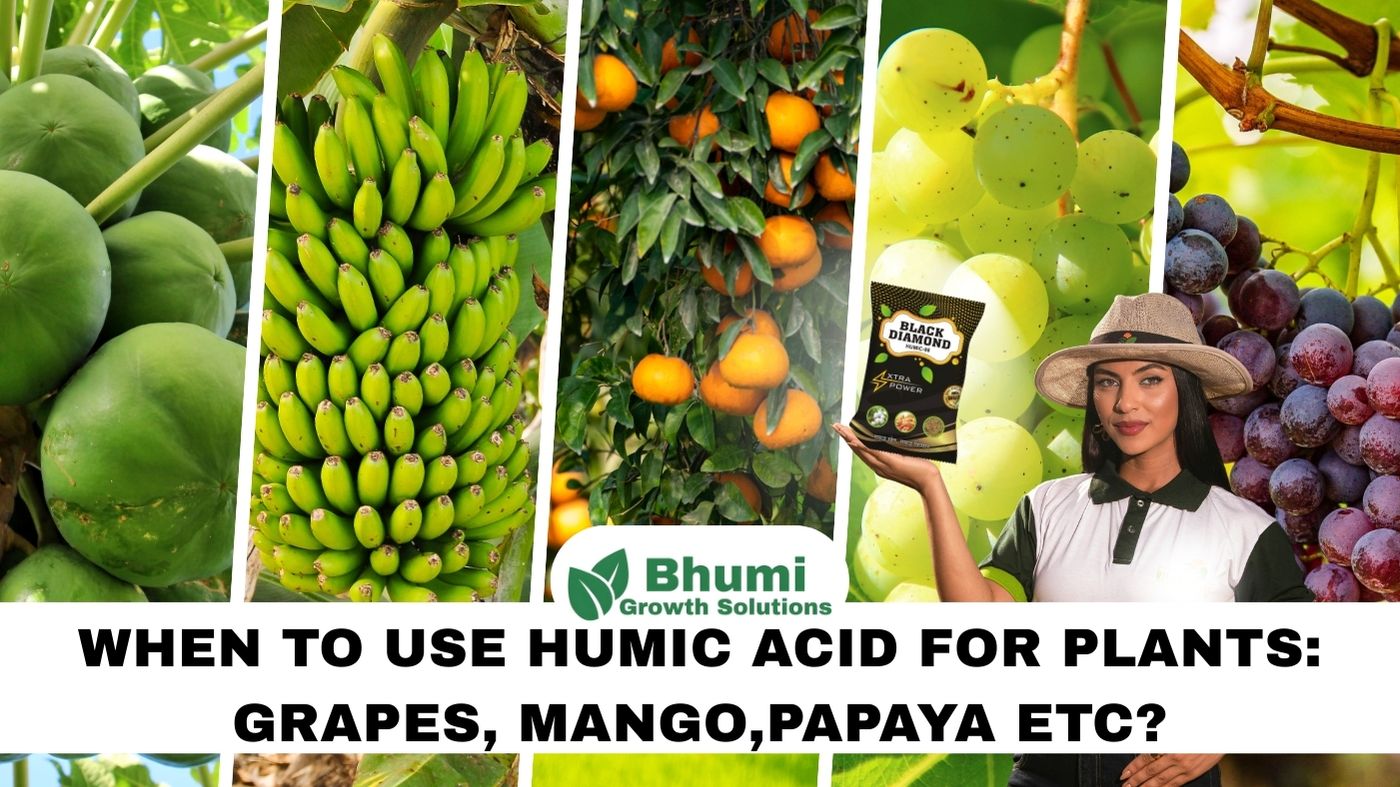When to Use Humic Acid for Plants in Indian Agriculture
Indian agriculture faces mounting challenges from soil degradation and declining fertility. Many progressive farmers are asking: when to use humic acid for plants to restore soil health and maximize crop productivity? The answer lies in understanding optimal timing for different crops, especially high-value fruits like grapes and papaya that demand precise nutrition management.
Proper timing of humic acid application can increase yields by 20-30% while improving fruit quality and shelf life. This comprehensive guide reveals the exact strategies successful Indian farmers use to maximize returns from humic acid investments.
The Science Behind Humic Acid Timing
Humic acid works by chelating nutrients and making them more available to plant roots. Its effectiveness depends heavily on soil temperature, moisture levels, and plant physiological stages. When to use humic acid for plants requires understanding these interconnected factors for maximum benefit.
Research shows that humic substances are most effective when soil microbes are active, typically when soil temperatures range between 15-30°C and moisture levels are optimal for root uptake.
When to Use Humic Acid for Different Plant Categories
Humic Acid for Vegetable Crops
For vegetable cultivation, timing revolves around critical growth phases:
Seedling Stage: Apply Black Diamond Humic Acid during soil preparation, 7-10 days before transplanting. This conditions the root zone and reduces transplant shock.
Vegetative Growth Phase: When to use humic acid for plants like tomatoes, brinjal, and capsicum is during active vegetative growth (15-30 days after transplanting). Apply at 2-3 kg per acre through drip irrigation.
Flowering and Fruiting: Critical applications during flower bud formation and early fruit development ensure adequate nutrient supply during high-demand periods.
Humic Acid for Field Crops
Rice: Apply during land preparation (before puddling), active tillering stage (25-30 days after transplanting), and panicle initiation stage. The water-logged conditions in rice fields make Black Diamond Humic Acid particularly effective as it remains active in anaerobic conditions.
Wheat: Key timing includes pre-sowing soil application, tillering stage (30-35 days after sowing), and grain filling stage. These applications support root development and grain quality.
Cotton: Apply during square formation and boll development stages when the plant’s nutrient demands are highest.
Can Humic Acid Be Used on Grapes?
Absolutely! Can humic acid be used on grapes is a common question, and the answer is definitively yes. Grapes respond exceptionally well to humic acid applications, showing improved fruit quality, yield, and plant vigor.
Optimal Timing for Grape Applications
Pre-Flowering Stage (February-March): Apply Bijlee Humic & Fulvic Acid at 2-3 liters per acre through drip irrigation. This supports flower bud development and improves pollination success.
Fruit Set Stage (April-May): Critical application timing that reduces fruit drop and improves berry development. Use foliar spray at 0.5% concentration (50ml per 10 liters water).
Veraison Stage (Color Development): Apply during early color change to enhance sugar accumulation and improve fruit quality. This timing is crucial for commercial grape production.
Post-Harvest (After Picking): Recovery application helps the vine store energy for next season’s growth and improves winter hardiness.
Benefits Specific to Grape Cultivation
Research conducted on Kalamata olive trees (similar fruit crop physiology) showed that foliar applications of humic acid during fruit set stages increased:
Fruit weight by 15-20%
Oil content by 5-8%
Overall yield by 10–25% (depending on soil and management conditions) compared to control
Similar benefits can be expected in grapes, including improved berry size, enhanced sugar content, and better color development.
Can Humic Acid Be Used on Papaya?
Can humic acid be used on papaya is another frequent question from tropical fruit growers. Papaya cultivation benefits tremendously from properly timed humic acid applications, showing remarkable improvements in plant growth and fruit production.
Papaya Application Schedule
Nursery Stage: For papaya seedlings, apply Bijlee Humic & Fulvic Acid as foliar spray at 0.3% concentration weekly. This improves seedling quality and root development.
Transplanting Stage: Soil application of Black Diamond Humic Acid at 3-5 kg per acre during land preparation reduces transplant shock and establishes strong root systems.
Vegetative Growth Phase: Monthly applications during the first 6 months support rapid trunk development and leaf formation. Apply through drip irrigation at 2-3 kg per acre.
Flowering Initiation: Critical timing at 6-8 months after transplanting when first flowers appear. This application supports flower development and fruit set.
Fruit Development Stage: Continuous applications every 30–45 days during fruit development, depending on crop condition and soil response improve fruit size, sugar content, and overall quality.
Benefits for Papaya Cultivation
Studies demonstrate that humic acid applications on papaya result in:
Improved aerial part and root system development
Enhanced seedling quality and survival rates
Increased fruit size and quality
Better plant resistance to environmental stress
Higher overall productivity per plant
Application Methods for Different Crops
Soil Application Method
Mix Black Diamond Humic Acid thoroughly with water and apply through:
Drip irrigation systems (most efficient)
Flood irrigation (for field crops)
Manual application around plant base (for fruit trees)
Dosage Guidelines:
Vegetables: 2-3 kg per acre
Field crops: 5-8 kg per acre
Fruit trees: 3-5 kg per acre
Foliar Application Method
When to use humic acid for plants as foliar spray depends on crop sensitivity and growth stage:
Concentration: 0.3-0.5% for sensitive crops like papaya seedlings, 0.5-1% for established plants
Timing: Early morning (6-9 AM) or evening (4-6 PM) to prevent leaf burn
Frequency: Every 15-20 days during active growth phases
Bijlee Humic & Fulvic Acid is specially formulated for foliar applications with optimal molecular size for rapid leaf absorption.
Combination Applications
Advanced farmers combine soil and foliar applications for maximum benefit:
Soil application for long-term nutrient availability
Foliar application for rapid plant response during stress periods
Tank mixing with compatible fertilizers for comprehensive nutrition
Seasonal Considerations for Different Regions
North Indian Plains
Rabi Season (October-March): Ideal for wheat, mustard, and winter vegetables. Apply during cool, moist conditions when soil microbial activity is moderate but steady.
Kharif Season (June-September): Perfect for rice, cotton, and monsoon vegetables. High temperature and moisture create optimal conditions for humic acid effectiveness.
South Indian Conditions
Summer Crops (March-June): Require frequent applications due to high temperatures and rapid nutrient uptake. Apply during cooler hours and ensure adequate soil moisture.
Monsoon Crops (June-November): Extended growing season allows multiple applications. Time applications between rain events for maximum absorption.
Western Indian Regions
Post-Monsoon Period (October-February): Ideal for grape harvest recovery and winter crop establishment. Moderate temperatures favor steady nutrient release.
Monitoring Plant Response and Adjusting Timing
Successful farmers monitor plant indicators to optimize application timing:
Visual Indicators:
Leaf color and vigor
Root development (visible in young plants)
Flowering intensity and timing
Fruit set and development rate
Soil Indicators:
Soil pH and EC levels
Organic matter content
Microbial activity (soil respiration)
Water retention capacity
Common Mistakes in Timing and How to Avoid Them
Over-Application: Avoid applying during plant dormancy or extreme stress conditions. Plants cannot effectively utilize nutrients during these periods.
Wrong Weather Timing: Never apply during extreme heat, cold, or immediately before heavy rains that can wash away the application.
Ignoring Crop Stages: Each crop has specific high-demand periods. Missing these windows reduces application effectiveness significantly.
Frequently Asked Questions
Q: When to add humic acid to lawn areas around fruit trees?
A: Apply during spring growth initiation (March-April) and post-monsoon recovery (October-November). Use 1-2 kg per acre for optimal grass health without competing with tree roots.
Q: Can humic acid be applied with other fertilizers?
A: Yes, both Black Diamond Humic Acid and Bijlee Humic & Fulvic Acid are compatible with most water-soluble fertilizers. This combination enhances fertilizer efficiency by 20-30%.
Q: How long do the effects of humic acid last?
A: Soil applications typically remain effective for 45-60 days, while foliar applications provide immediate but shorter-term benefits lasting 15-20 days.
Q: Is there any risk of over-application?
A: Humic acid is generally safe when used at recommended doses. However, very high concentrations (e.g., over 1.5% in foliar sprays) may risk leaf scorch. However, excess applications are wasteful and don’t provide additional benefits.
Economic Benefits and Return on Investment
Proper timing of humic acid applications provides excellent economic returns:
Direct Benefits:
20-30% yield increase in most crops
Improved fruit quality and market price
Reduced fertilizer requirements
Enhanced plant disease resistance
Indirect Benefits:
Improved soil health over time
Better water retention reducing irrigation costs
Extended productive life of fruit trees
Sustainable farming practices meeting market demands
Quality Products for Maximum Results
Black Diamond Humic Acid provides consistent results for soil applications with its high purity leonardite source and optimal pH range. The water-soluble powder format ensures complete dissolution and uniform application.
Bijlee Humic & Fulvic Acid offers enhanced benefits for foliar applications and specialty crops like grapes and papaya. The combined humic and fulvic acid formula provides both immediate and long-term benefits.
Conclusion
Understanding when to use humic acid for plants is crucial for maximizing agricultural productivity and profitability. Whether you’re growing grapes in Maharashtra, papaya in Andhra Pradesh, or vegetables in Punjab, proper timing ensures optimal results.
The key is matching application timing with crop growth stages, seasonal conditions, and soil characteristics. Can humic acid be used on grapes and can humic acid be used on papaya? Absolutely, with remarkable benefits when timed correctly.
Order Black Diamond Humic Acid and Bijlee Humic & Fulvic Acid today from Bhumi Growth Solutions to boost your soil health and crop yield. Join thousands of successful farmers who have transformed their agricultural productivity through scientifically timed humic acid applications.



